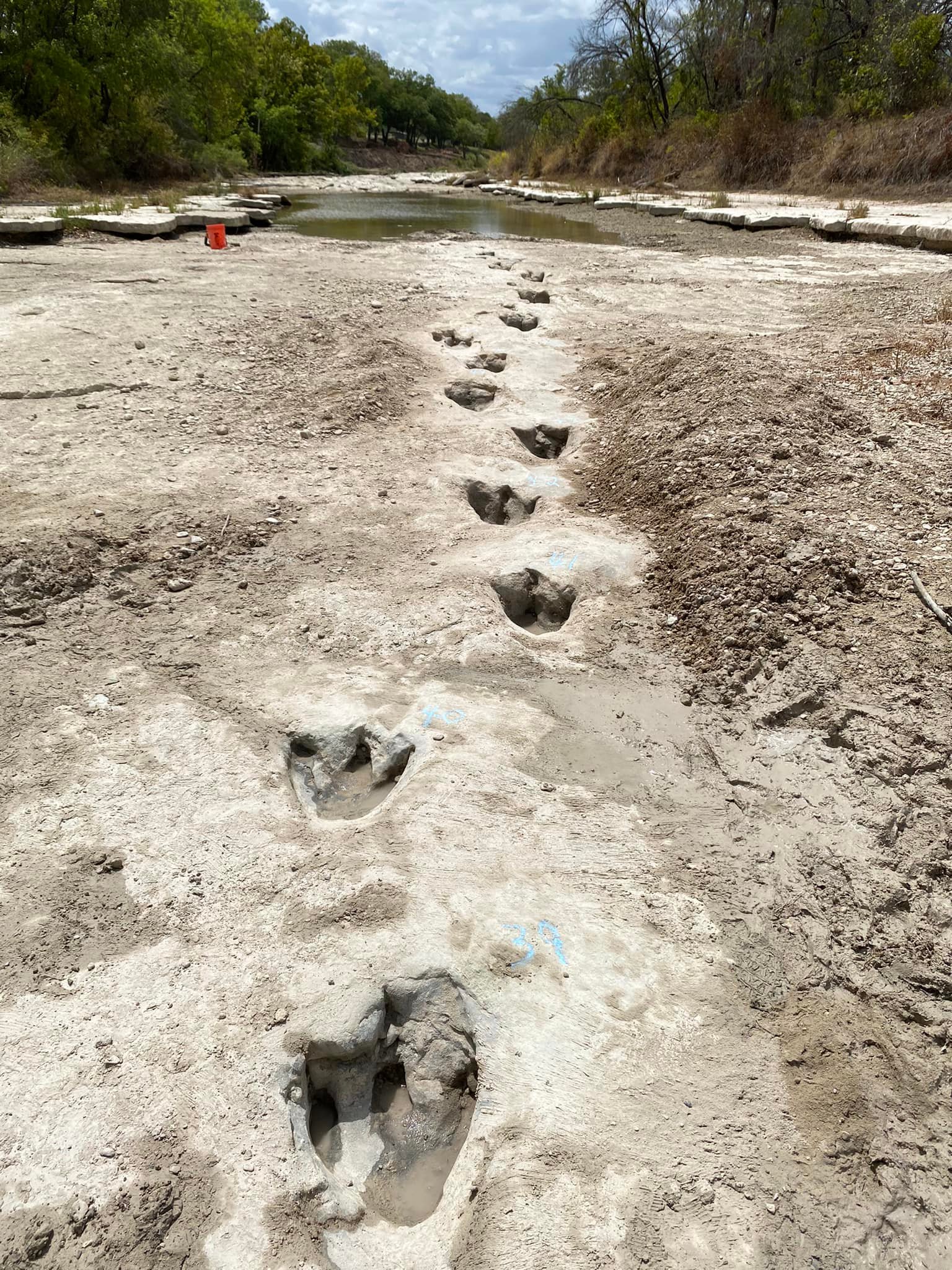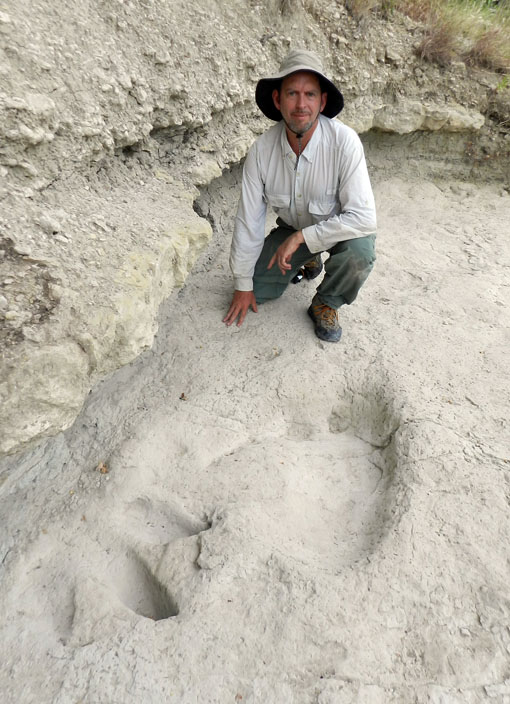How to Verify If Glen Rose Dinosaur Tracks Are Real
To verify the authenticity of Glen Rose dinosaur tracks, examine their shape, depth, and the surrounding sediment. Consult with paleontologists for a professional evaluation.
Glen Rose, Texas, is renowned for its well-preserved dinosaur tracks, enticing both enthusiasts and skeptics.
Authenticating these tracks involves a few key steps that help distinguish genuine prehistoric footprints from natural erosions or modern fabrications.
Considering the significant scientific and historical value of these fossils, ensuring their authenticity is paramount.
Curious visitors and researchers alike seek to confirm that the tracks are indeed real, as they offer a direct connection to the Earth’s distant past.
This verification process not only adds credibility to the site but also enriches our understanding of these ancient creatures and their interactions with the environment millions of years ago.

Tracing The Origins Of Glen Rose Dinosaur Tracks
Have you ever wondered about the authenticity of dinosaur tracks? The Glen Rose Dinosaur Tracks spark imagination and curiosity. Let’s dig into their origins.
The Geology Of Glen Rose
Glen Rose, Texas, is world-renowned for its well-preserved dinosaur tracks. These tracks lie within the Paluxy River bed and date back to the Cretaceous period.
The area’s unique sedimentary rock formation captured the footprints of ancient creatures, turning them into fossils over time.
Limestone layers, which once formed the prehistoric coastline, serve as the canvas for these natural relics. Multiple floods over millions of years exposed and conserved the tracks, offering us a glimpse into the past.
Historical Discovery And Initial Studies
Interest in the Glen Rose tracks piqued in 1909 with the discovery by local resident Charlie Moss. He spotted unusual depressions in the riverbed, which later became recognized as dinosaur footprints.
In the 1930s, further studies conducted by Roland T. Bird from the American Museum of Natural History brought significant attention to these tracks.
Bird’s efforts led to a comprehensive study and excavation, solidifying Glen Rose’s place in paleontological history.
| Time Period | Geological Formation | Significance |
|---|---|---|
| Cretaceous | Limestone | Preservation of dinosaur tracks |
| 1909 | Initial Discovery (Charlie Moss) | First recognition of tracks |
| 1930s | Research and Excavation (Roland T. Bird) | Increased scientific interest |
The tracks became a cornerstone for not only regional but also for global scientific communities, marking Glen Rose as a site of significant paleontological importance.

Credit: texashighways.com
Key Characteristics Of Authentic Dinosaur Tracks
The mystery of prehistoric life sparks excitement in both young and old. Among the most thrilling evidences of ancient creatures are dinosaur tracks, like those found in Glen Rose.
Yet, distinguishing real tracks from natural rock formations requires a discerning eye. Let’s delve into the key characteristics that signify genuine dinosaur footprints.
Identifying True Tracks Vs. Erosion Patterns
Not all marks in stone are dinosaur footprints. Natural erosion can create patterns that resemble tracks. True dinosaur tracks have distinct qualities:
- Consistency in Shape: Real tracks typically show a repeated pattern. Each print in a series looks similar.
- Depth and Definition: Dinosaur footprints press deep into the sediment, displaying well-defined edges.
- Symmetry: Authentic tracks often show symmetry indicative of walking behavior.
- Directionality: A sequence of prints will have a clear direction, suggesting the movement of a dinosaur.
Physical Features Of Real Dinosaur Footprints
Recognizing real dinosaur footprints among fossils involves examining specific physical features.
| Feature | Description |
|---|---|
| Shape | Three-toed for theropods, rounded for sauropods. |
| Size | Varies but corresponds to expected dinosaur sizes. |
| Texture | Skin imprints might be visible within the track. |
| Depth | Deeper in the heel area, shallower at the toes. |
| Position | Indicates the stance and gait of the dinosaur. |
In-depth analysis of these features helps confirm the authenticity of dinosaur tracks. Experts compare them to known data from other genuine tracks. This examination aids in the validation of the Glen Rose dinosaur tracks.
Techniques Used In Authentication
The authentication of Glen Rose dinosaur tracks involves meticulous scientific processes. Specialists use several techniques to distinguish real tracks from fakes or natural rock formations.
These techniques ensure that any dinosaur track discovery is a genuine piece of prehistoric life.
Comparative Analysis With Known Specimens
Comparative analysis is a key method in studying dinosaur tracks. This involves examining the suspected tracks and comparing them with confirmed specimens. Scientists look at several factors:
- Size and shape to match known dinosaur footprints.
- Depth and pressure distribution, which indicate the weight of the dinosaur.
- Stride and pace, showing the dinosaur’s walking pattern.
These comparisons offer insight into the track’s authenticity and the type of dinosaur that made them.
The Role Of Paleontologists In Verification
Paleontologists play a crucial role in the verification process. They possess the expertise needed to:
- Determine the geological context of the find.
- Conduct thorough rock and fossil analyses.
- Use advanced imaging and scanning to study the tracks in detail.
The involvement of paleontologists helps assure that the verification process is accurate and professional.
Modern Technologies In Fossil Verification
The authenticity of Glen Rose dinosaur tracks sparks fascination and inquiry. Employing modern technologies assists experts in determining their legitimacy. Such technologies make verifications precise and less speculative.
3d Imaging And Analysis
Visualizing fossils in three dimensions revolutionizes their study. Experts use 3D scanning tools to capture every detail of the Glen Rose dinosaur tracks. The process involves:
- Scanning the tracksite with specialized equipment
- Creating digital models that showcase the tracks’ depth, shape, and size
- Comparing models to known dinosaur footprints for species identification
Analyses allow paleontologists to reconstruct the dinosaurs’ gait. They gain insights into the creatures’ behavior and the environment from millions of years ago.
Radiometric Dating Methods
Radiometric dating offers a timeline for fossil formation. It measures isotope decay within the rock layers encasing the tracks. Key steps:
- Collection of rock samples around the tracks
- Assessment of radioactive isotopes present within the samples
- Calculation of the age based on decay rates
The age estimation helps confirm the period when the tracks were made. Accuracy of these methods supports the real timeline of the dinosaurs’ existence.
Interpreting Dinosaur Trackways
Unearthing the secrets of the ancient world often starts at our feet with dinosaur trackways. These natural history records offer a glance into prehistoric life, capturing a moment in time when dinosaurs walked the Earth.
In Glen Rose, Texas, the dinosaur tracks are a source of intrigue for scientists and enthusiasts alike. To verify the authenticity of these tracks, careful analysis is required. Let’s delve into the methods used to interpret these fascinating footprints from the past.
Gait Analysis And Track Patterns
Gait analysis is a scientific method that studies how dinosaurs moved. Just like detectives, paleontologists look for clues in the distance between tracks, the depth of each imprint, and the overall track pattern.
These factors reveal if a dinosaur walked or ran and how it balanced its weight.
- Steps lengths show speed.
- Track depths hint at weight.
- Foot positioning suggests walking style.
| Track Feature | Indication |
|---|---|
| Overlapping Tracks | Possible herd movement |
| Varying Depths | Different sizes or species |
| Consistent Patterns | Same dinosaur movement |
By piecing together these details, a comprehensive analysis can confirm whether the Glen Rose dinosaur tracks are genuine.
Insights Into Dinosaur Behavior
Dinosaur trackways offer more than just footprints; they give insights into dinosaur lives. These impressions can tell stories about how dinosaurs interacted with each other and their environment.
- Straight lines might mean purposeful movements.
- Parallel tracks can indicate group travel.
- Circular patterns may suggest searching for food or nesting.
Patterns of footprints allow us to guess behaviors like hunting, mating dances, and parenting roles. Hence, trackways are key to understanding the social life of these colossal creatures.
With diligent observation, the true narrative behind the Glen Rose tracks comes to life, bridging the gap between our world and the age of dinosaurs.
Common Misconceptions And Hoaxes
Dinosaur tracks fascinate researchers and tourists alike. Glen Rose dinosaur tracks are no different.
Yet, misconceptions and hoaxes often mislead the public. This post details how to spot forgeries and promote knowledge.
Identifying Forgeries And Fake Tracks
Distinguishing real from fake is not always easy. Knowing what to look for helps.
- Texture and patina: Real tracks have a consistent weathering pattern.
- Edge definition: Genuine tracks show natural erosion; forgeries may not.
- Rock layers: Tracks must align with geological strata.
| Characteristic | Real Track | Forged Track |
|---|---|---|
| Texture | Weathered | Varies |
| Edges | Natural erosion | Too sharp/clean |
| Layer Alignment | Consistent | Off |
Public Education To Prevent Misinformation
Educational programs are key in fighting misconceptions.
- Interactive sessions for schools
- Public talks by palaeontologists
- Authentic information booklets
Regular workshops also enable enthusiasts to learn the science behind real tracks.
Protecting Glen Rose Dinosaur Tracks
The dinosaur tracks in Glen Rose, Texas, represent a remarkable window into the past. These natural treasures, etched into the Earth’s history, require careful preservation to endure the passage of time.
Ensuring these tracks’ authenticity and integrity not only fascinates us but also educates future generations.
Conservation Efforts For Paleontological Sites
- Regulated Access: Limiting exposure to weather and footsteps.
- Continual Monitoring: Regularly assessing the condition of the tracks.
- Maintenance: Addressing erosion and any damage promptly.
Organizations and volunteers work as guardians of these historical footprints. Local authorities collaborate to maintain the sites. Researchers contribute by studying the tracks without harming them.
Legal And Ethical Considerations In Fossil Collection
- Observe Property Rights: Always get permission from landowners.
- Respect Regulations: Follow laws laid out by government agencies.
- Report Discoveries: Share findings with the scientific community.
Gathering fossils comes with responsibility. Collectors must honor legal boundaries. It is essential to preserve the original state of these sites for ongoing scientific research and educational purposes.

Credit: www.georgialifetraces.com
Frequently Asked Questions On How To Verify If Glen Rose Dinosaur Tracks Are Real
Are The Dinosaur Tracks In Glen Rose Real?
Yes, the dinosaur tracks in Glen Rose, Texas, are authentic. Visitors can see these prehistoric footprints at the Dinosaur Valley State Park.
How Do You Identify Dinosaur Tracks?
To identify dinosaur tracks, look for three main features: size and shape matching known species’ footprints, a distinct outline with toe impressions, and a pattern consistent with dinosaur gait. Examine the rock layer age to confirm the period.
Are The Tracks At Dinosaur Ridge Real?
Yes, Dinosaur Ridge features genuine fossilized dinosaur tracks. Visitors can view over 300 authentic dinosaur footprints at this renowned natural landmark.
What Are The New Tracks In Glen Rose?
Glen Rose recently unveiled new dinosaur tracks at the Dinosaur Valley State Park, adding exciting exhibits for visitors to explore.
Conclusion
Verifying the authenticity of Glen Rose dinosaur tracks need not be daunting. Adopt a thoughtful approach, employing professional assessments and scientific techniques.
Remember, accurate identification preserves history and fuels passion for paleontology. Embrace your curiosity—real discoveries await your investigative spirit.
Keep exploring, keep learning.





